Semper Prowler – JED, April 2019
– By Rick Morgan –
On Friday, 8 March, 2019, the United States Marines deactivated Marine Tactical Electronic Warfare Squadron-TWO (VMAQ-2) at Marine Corps Air Station (MCAS) Cherry Point, NC. This ceremony marked several distinct milestones, including 68 years of service for the squadron and its predecessors, as well as the final retirement for the Grumman EA-6B Prowler after 48 years of duty. This event comes four years after the Navy ended its long association with the Prowler, having replaced the classic airframe with the Boeing EA-18G Growler.
For the Marines, it’s a bittersweet point in history, as the Corps has always been at the forefront of what we now call Airborne Electronic Attack (AEA), having conducted the business with panache since the Korean War.
For VMAQ-2, the oldest of the four Marine Prowler units, it secures its colors after seeing combat in Vietnam and over Iraq, the former Yugoslavia, Afghanistan, Syria and off Libya. The squadron’s simple motto, “Can Do” (or, as commonly seen, “Can Do Easy”) said it all, and became ample evidence of what Marine airborne EW has accomplished over many decades. As is often said, “It’s not boasting if it’s true.”
BEGINNINGS
While the Marines certainly experimented with what was called “Radio Countermeasures” during World War II, it was during the Korean War that specialized units were formed to emphasize the use of electronics and expanding technology to support the Marine Rifleman on the ground.
Up to late 1951, the Marines had assigned small numbers of night-attack and ECM-capable Douglas Skyraiders, and a limited number of Grumman TBM-3Q Avengers to headquarters and maintenance units. The rapidly growing need for these capabilities led to the Corps activating three new Marine Composite Squadrons (VMC) in 1951 and 1952.
The initial roles for these squadrons was night attack and airborne early warning, with a variety of specialized Douglas AD Skyraiders assigned. Through the early to mid-1950s, these units continued to experiment on improving their capability by acquiring existing jamming equipment and mounting it in their aircraft.
Their work continued through 1955, when the decision was made to merge the VMC units with Marine Photo Reconnaissance Squadrons (VMJ) to form what were now titled Marine Composite Reconnaissance Squadrons (VMCJ). VMC-2 and VMJ-2 were merged on 1 December, 1955 to form VMCJ-2 at Cherry Point. VMC-3 and VMJ-3, now at El Toro, CA, did the same on the same date. It took a little longer for the 1st Marine Air Wing to follow suit, with VMC-1 and VMJ-1 joining on 31 July 1958.
Changes were coming for the new VMCJ squadrons as, during the same period, the Marines had recognized the need to have a full-time jet-powered electronic warfare aircraft. This requirement preceded the other Services, as the Navy retained propeller-driven AD Skyraiders for the mission (as AD-5Qs), and the Air Force’s Tactical Air Command held only a few, outdated Douglas B-26s for the role.
The Marines decided to use the Douglas F3D-2 Skyknight as a dedicated EW platform, with 35 eventually being modified to carry receiver systems and jammers. By the end of the 1950s, all three VMCJ squadrons had settled on two types of aircraft, F3D-2Qs for the EW mission and new Vought F8U-1Ps conducting photo-recon. Both would see duty around Cuba during the 1962 missile crisis; the photo birds conducting low-altitude missions and “Willy the Whale,” as the F3Ds were frequently called, recording valuable ELINT data for other agencies.
SERVICE IN VIETNAM
In 1962, a service-wide re-designation effort led to both aircraft becoming the EF-10B and RF-8A, and that’s what they started with in Vietnam as VMCJ-1 left its Iwakuni, Japan home to take residence in Da Nang for the duration of the war.
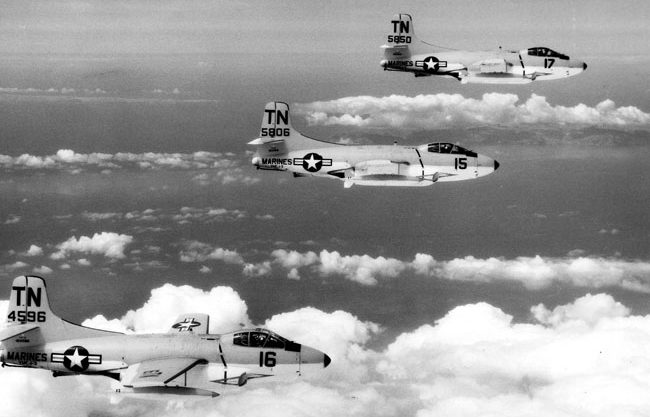
The Marines pioneered the use of jet aircraft as tactical jamming platforms through introduction of the Douglas F3D-2Q (EF-10B) Skyknight in the late 1950s. Here, a division from VMCJ-3 fly in echelon. The EF-10B would serve with distinction in Vietnam, not being retired until 1970. – US Marine Corps Photo
By the start of the Vietnam War, the trio of VMCJ squadrons had stabilized with a mix of Skyknights and Photo-Crusaders. The Marines soon found their EF-10Bs in high demand to provide jamming support for strikes deep in North Vietnam, particularly as Soviet-supplied SA-2 Surface-to-Air Missiles (SAMs) began impacting US strike operations.
The “Drut,” as the Skyknight was also called, was flown heroically day and night, facing both MiG and SAM threats in support of Marine, Navy and Air Force strikes. To put it succinctly, only the Marines would fly a corpulent, non-ejection seat, straight-winged, sub-sonic jet that burned AVGAS against SA-2s. And, in the finest traditions of the Corps, they made it work. There was a cost, of course; five EF-10Bs being lost during the war due to both combat and operational causes.
Help was on the way, however, as in the early 1960s, the Marines were working with Grumman to develop a replacement for the Skyknight. This aircraft, derived from the A2F (A-6) Intruder, would first fly in April 1963 as the EA-6A. The “Electric Intruder,” as it was eventually called, retained the strike aircraft’s two-seat design but also featured new, podded jammers and an excellent receiver system.
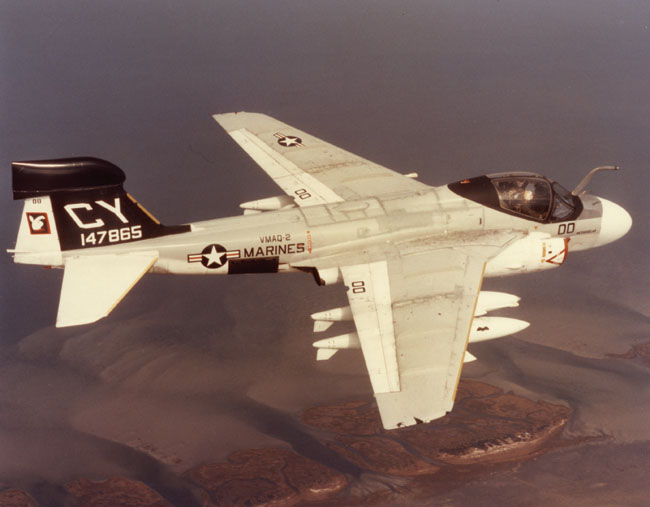
The Grumman EA-6A Intruder replaced the EF-10B as the Marines’ tactical jamming platform from 1966 and also saw widespread service in Vietnam. Charlie Yankee 00, shown here, is the legendary “Methuselah,” the second Intruder built and first modified to the electronic attack version. It’s shown about 1977 in full VMAQ-2 “Playboy” markings. The airframe is now on display at MCAS Cherry Point, NC. – US Marine Corps photo
Twenty-seven EA-6As would be either modified from bombers or built new and delivered to the three VMCJ squadrons to completely replace the EF-10B by the end of 1969. The new aircraft entered combat in Vietnam with VMCJ-1 in October 1966 and quickly proved itself to be the most capable jamming aircraft used in the war, with an excellent blend of frequency range and jamming power, as well as airframe endurance, speed and survivability.
VMCJ-1 continued to fly combat out of Da Nang through 1970, when it returned to Japan. Meanwhile, VMCJ-2 and -3 continued training in CONUS and supporting “CJ-1.” The “Playboys” of VMCJ-2 also made two deployments in aircraft carriers with the 6th Fleet in 1971, marking the first time the EA-6A was part of a Navy Carrier Air Wing (CVW).
The invasion of South Vietnam by the North in April 1972 led to VMCJ-1 returning to war with its Intruders, now flying missions out of Cubi Point, Philippines. They were joined by a detachment from VMCJ-2, adding their significant weight of wattage to the electronic attack effort in Operations Linebacker and Linebacker II. Two EA-6As would be lost during the 1972 effort, one in combat, the other to a complete hydraulic failure.
THE PROWLER ARRIVES
The end of the Vietnam War in 1973 quickly led to “Ops Normal” for all three VMCJ squadrons. VMCJ-1 soon picked up additional duties covering the EW and photo-recon roles for the USS Midway (CVA-41) and Carrier Air Wing-FIVE (CVW-5) out of Japan. VMCJ-3 continued flying out of sunny Southern California, while Cherry Point-based VMCJ-2 worked with the 2nd MAW, as well as continuing periodic operations monitoring Cuba.
In 1975, the Marines elected to completely change the organization of the composite units, as they decided to split the two missions into separate squadrons. On 1 July 1975, VMCJ-2 was re-designated Marine Tactical Electronic Warfare Squadron-TWO (VMAQ-2), now having sole custody of all EA-6As in the DOD inventory. The same day, VMCJ-3 became VMFP-3, gaining all of the Corps’ RF-4B Phantom IIs. VMCJ-1, in Japan, was deactivated, their place being covered by detachments from the two “new” squadrons, who were now deploying under the recently instituted Unit Deployment Plan (UDP).
The “Playboys” of VMAQ-2 now covered Marine electronic attack assignments world-wide with their black-tailed Intruders seen from Norway to Japan, continuing their tradition of excellence in the EW field. The EA-6A itself was overdue for replacement, and in 1977, the Marines took possession of their first Grumman EA-6B Prowler.
The Prowler, a four-seat EW derivative of the Intruder, had been introduced by the Navy directly into combat in 1972. While the initial “Standard” version of the EA-6B didn’t have the frequency coverage of the EA-6A’s EW suite, rapid improvements to the type quickly outstripped the capability of the A-model, with the Marines starting with the “Improved Capability” (ICAP) model of the Prowler. As part of a unique set of requirements for the Marines, they also installed the AN/ASQ-90A Tactical Electronic Reconnaissance Processing and Evaluation System (TERPES) digital recording device in their Prowlers. TERPES would remain unique to the Marines, as the Navy believed its VQ electronic reconnaissance community carried out the same basic function. For the purposes of deployment, VMAQ-2 organized three standing detachments (X, Y and Z) and launched its first det overseas with the type, to Japan, in December 1978.
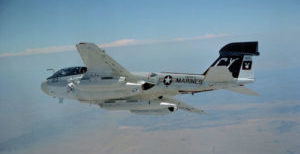
VMAQ-2 started receiving EA-6B Prowlers in 1977, replacing their two-seat EA-6As. This picture shows an ICAP-version in full “Playboy” markings in 1982. – US Marine Corps photo
Thus was set the operational routine for VMAQ-2 for over 15 years, with detachments rotating to Japan, typically for six months, after spending a year home in North Carolina. They also continued to cover the EW requirement for CVW-5 and Midway, finally being relieved by the permanent move of VAQ-136 from Whidbey Island in early 1980. While in Japan, the squadron’s Prowlers typically covered exercises throughout the region while also keeping a wary eye on North Korea.
In 1982, the “Playboys” made their first extended carrier deployment to the Mediterranean with Prowlers, placing det Y aboard the USS Nimitz (CVN-68) as part of CVW-8. Two years later, det X joined CVW-17 and USS Saratoga (CV-60) for another Med deployment.
Most notable was the short-fused assignment of Detachment Y to USS America (CV-66) in January 1986. A crisis with Libya had led to America and CVW-1 losing their own Prowler squadron, VAQ-135, which had been moved to CVW-13 on USS Coral Sea (CV-43). The Marines were selected to fill the EW gap, quickly carrier qualified and headed to the Med. On 15 April, they supported Operation El Dorado Canyon, which involved strikes by Navy and US Air Force aircraft against targets in Libya. It would also be the first combat for Marine Prowlers. Later in 1986, VMAQ-2 started accepting their first Improved Capability II (ICAP-II) EA-6Bs, which also introduced the AGM-88 High Speed Anti-Radiation Missile (HARM) to their bag of tricks. Roughly four years later, in 1990, VMAQ-2 would answer the bell again as the Iraqi invasion of Kuwait quickly led to the largest deployment of US forces since the Vietnam War.
THE GULF WAR
When the word came to send Prowlers to Southwest Asia, the “Playboys’” det X was in Iwakuni Japan. They would be fated to remain in Japan for a year, as the remainder of the squadron was moved in August 1990 to a previously unknown base in southern Bahrain named Shaikh Isa. Their twelve Prowlers became the largest single-squadron deployment for the type up to that point. They jumped right into Operation Desert Shield and prepared for what appeared to be the imminent liberation of Kuwait.
The start of the war on Iraq, now called Operation Desert Storm, started on the night of 17 January 1991, while practically the entire world watched on television as Allied missiles and aircraft attacked Baghdad in spectacular fashion. VMAQ-2 joined 29 Navy Prowlers, Air Force EF-111A Ravens, and EC-130H Compass Call aircraft to form an electronic warfare hammer that subdued and helped eventually destroy Iraq’s air defense system.
RE-ORGANIZATION
Over the following six-week war, the “Playboys” performed heavy electronic bombardment throughout the war zone in support of strikes by Marine aircraft, as well as all of the other Allied Air Forces. From mid-February, they also launched HARMs on suitable targets. When all was said and done, and Kuwait was liberated, the squadron had flown over 1600 hours and in excess of 500 combat missions. Most of the squadron returned home triumphantly in early April, other than a det that had been quickly formed to stay in Bahrain for the immediate post-war period.
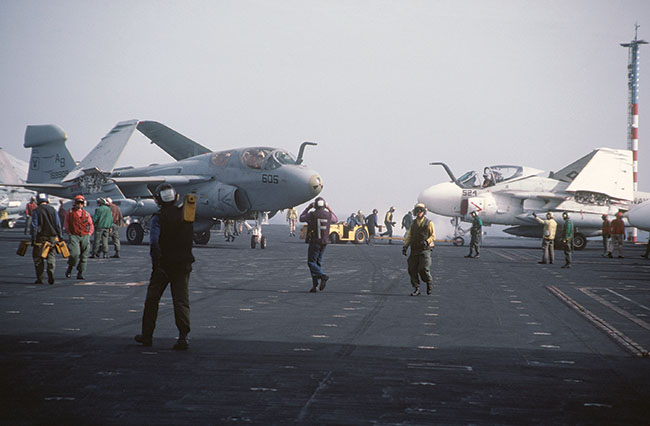
Marine Prowlers were no strangers to carrier operations. In 1986, VMAQ-2 det Y deployed in the USS America (CV-66) as a member of Carrier Air Wing-ONE. They would participate in Operation Eldorado Canyon, involving strikes on Libya, during the cruise. Playboy 605 is shown here taxiing onboard the ship with a VA-34 KA-6D tied down in the background. – US Navy photo
Meanwhile, Det X finally came back to North Carolina as well, in June, being relieved by an activated Reserve squadron, VMAQ-4. The “Seahawks” of VMAQ-4 had been formed in the Marine Reserves at NAS Whidbey Island, WA, in November 1981 with EA-6A Intruders as equipment. The squadron operated as part of the 4th Marine Air Wing for 19 years before being activated into the Regulars on 11 March 1991, with immediate transition to the EA-6B. Their hurry-up transition completed in June, they immediately moved to Iwakuni to take over the role as resident Prowler squadron in Japan. The Seahawks returned home to Whidbey in September and were de-mobilized to become the only Marine Reserve Prowler squadron. This status didn’t last long, as on 1 October 1992, they were activated again into the Regulars and moved to Cherry Point as part of a massive re-organization of Marine Prowler assets.
The decision had been made to expand (“clone”) each of VMAQ-2’s detachments into full squadrons, which, when joined by VMAQ-4, would give the Corps four deployable EA-6B units. On 1 July 1992, Detachment Zulu was activated as VMAQ-3, taking the nickname “Moon Dogs.” Det X-ray became VMAQ-1, the “Screamin’ Banshees,” and detachment Yankee remained as the core for VMAQ-2, which had changed its name to the “Panthers” after having been induced to lose the “Playboy” title after fall-out from the 1991 Tailhook Convention. By 1996, they would change their nickname again, now to “Death Jesters.”
Each squadron was equipped with six Prowlers, making them larger than their Navy counterparts, which still typically deployed with four or five aircraft per squadron. Deployments initially remained to Japan under the UDP, although that would soon change. VMAQ-1 would be the first of the new squadrons to leave the nest, heading to Iwakuni soon after activation.
The mid-1990s were notable for the substantial reduction in forces the US military took as the Nation looked for an elusive “Peace Dividend” after the Cold War. While the Navy initially lost three Prowler squadrons during this period, the Marines retained all four of theirs, even while several Leatherneck fighter and attack units were deactivated.
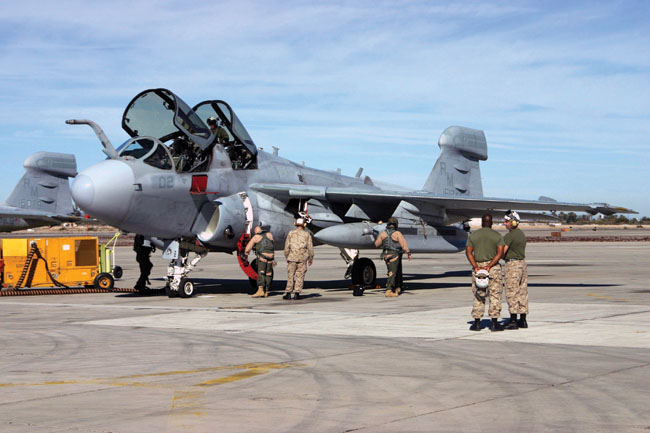
The Seahawks of VMAQ-4 started as a Marine Reserve squadron and drew their name from the Seattle NFL football team. Shown here at Yuma in 2005 well after being made a Regular Marine unit, Marine Prowlers were familiar and critical participants in training events at Yuma conducted by Marine Aviation Weapons and Tactics Squadron-ONE (MAWTS-1). – US Marine Corps Photo
As part of the drawdown, VMAQ-3 deployed to the Med in August 1995 as a member of Carrier Air Wing-ONE on the America. They replaced a Navy squadron for this one cruise and carried out a highly successful last-carrier deployment by a Marine Prowler unit. They also participated in growing operations over the former Yugoslavia as part of Operation Deliberate Force.
The Balkan region itself had rapidly destabilized in the early 1990s, with both the United Nations and North Atlantic Treaty Organization (NATO) passing resolutions to bring peace to the area, through force, if necessary. In 1993, VMAQ-3 had made the first Marine deployment to Aviano, Italy, to cover Operation Deny Flight, which involved operations over Bosnia and Herzegovina, as well as Serbia.
Through this same period, the Air Force had made no secret that it wanted to retire its only tactical radar jamming platform, the EF-111A Raven. The Raven needed upgrades to keep up with the threat, and the Air Force was more inclined to develop “emerging technologies” (stealth being a major one) that it thought would be a better investment.
Several high-level studies later, the decision was made to make the Department of the Navy responsible for all tactical EW, with the Prowler being the surviving platform. The new, Joint concept, which began in 1997, made theater EW now more closely coordinated under the gaining Combatant Commander, such as PACOM, EUCOM or CENTCOM. The Navy would increase it useable EA-6B inventory to support four new “Expeditionary,” or land-based squadrons to cover the new requirement, while the Marines were also now part of the Joint arrangement.
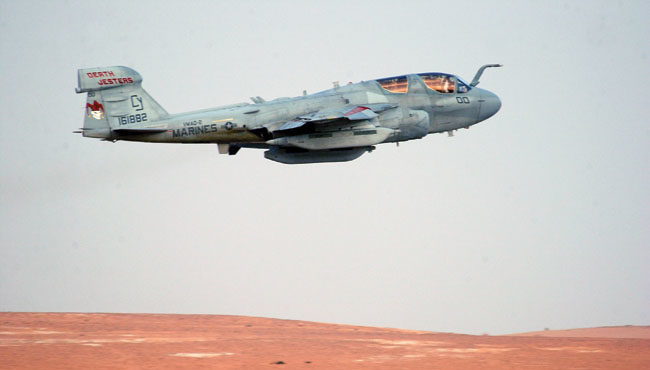
VMAQ-2 went through three different nicknames. By the time this picture was taken in March 2003, they were the “Death Jesters.” Charlie Yankee 00 is shown departing Prince Sultan Airbase in Saudi Arabia for a mission during Operation Iraqi Freedom. – US Air Force photo; SSGT Matthew Hannen
For the Marines, who would tell you they’d invented “Expeditionary EW,” they continued to deploy around the world, but now not always under a Marine Aircraft Group or in direct support of Marines on the ground. Exotic locations, such as Prince Sultan Air Base in Saudi Arabia and Incirlik, Turkey, would now start showing up on their list of deployed locations, all in support of ongoing operations, including Operations Northern Watch and Southern Watch, where they helped monitor the “No-Fly” zones established over Iraq.
Meanwhile, the Balkans continued to boil, and in October 1998, Operation Allied Force kicked off, which involved combat operations in support of NATO air forces throughout Serbia and Kosovo. Eleven Marine Prowlers – from VMAQ-1, 2 and 4 – participated alongside four US Navy EA-6B squadrons throughout the 78-day effort. Although three Air Force jets were shot down by radar-directed missiles during the Operation, it was noted that none of them had the benefit of adequate EW support when they were lost. The value of standoff jamming was once again proven, even for the highly-touted new “stealth” platforms. With the end of operations in the Balkans, the VMAQ units stood-down for a short period and then went back to “routine” deployments to Japan, Saudi Arabia, Turkey and Italy. The terrorist attacks, on 11 September, 2001, quickly increased the tempo of operations yet again and began another 18 continuous years of direct combat by Marine Prowlers.
IRAQ AND AFGHANISTAN
The Allied invasion of Iraq in 2003, as part of Operation Iraqi Freedom (OIF), would be heavily supported by Marine EA-6Bs, initially flying from Saudi Arabia. Once again, Marine EA-6Bs carried out vital work – initially to suppress Saddam Hussein’s integrated air defense network and then adapting to force protection missions, particularly as improvised explosive devices (IEDs) became the preferred weapon of the insurgency. VMAQ units started deploying inside Iraq, initially to Talil in the summer of 2004, and then to the former MiG base at Al Asad a year later. These counter-IED operations, in continued support of OIF, dominated Marine Prowler deployments from 2005 through 2010.
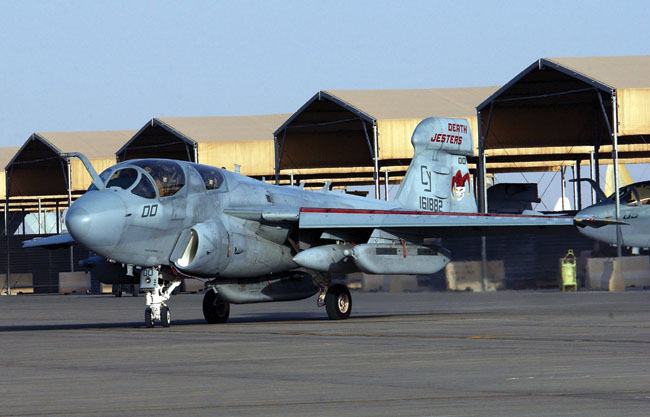
One of four Marine Prowler squadrons, VMAQ-1 made multiple deployments world-wide before becoming the replacement training squadron in 2013. This picture shows a “Screamin’ Banshee” EA-6B as it taxis at Prince Sultan AB in Saudi Arabia on 18 Mar 2003 for another sortie as part of Operation Iraqi Freedom. – US Air Force photo, SSGT Matthew Hannen
VMAQ operations in Afghanistan, as part of Operation Enduring Freedom, involved flying out of Bagram Air Base on multiple deployments from 2005 as they supported US and Allied troops on the ground, much of which was in what would have been previously considered “non-traditional” Electronic Warfare missions. As in Iraq, the presence of Prowler jamming quickly proved to be a lifesaver for troops on the ground. Vital to this effort, and in another example of Marine innovation, was the rapid installation of the AN/AAQ-28 LITENING Electro-Optical pod for EA-6B use, a piece of kit the Navy never adopted.
The deployment of aircraft in country led to significant force protection concerns for US troops, with VMAQ-2 actually being involved in an attack on Bagram Airfield led by Taliban insurgents in May 2010. The heavily armed raiders tried to enter the base near the squadron’s area and were quickly met by Leathernecks, who quickly reverted to their “Every Marine a Rifleman” training and repelled them with heavy Taliban losses. Two Marines were seriously wounded in the engagement.
Improved Capability III (ICAP III) EA-6Bs arrived from April 2010, with VMAQ-4 taking the first Marine examples to Afghanistan a year later. The ICAP III, which had been introduced into the Navy in 2005, featured a whole new “state-of-the-art” receiver system, the AN/ALQ-218, which was of the same basic design as what would go into the Growler. The ICAP III would prove to be the ultimate expression of the Prowler and a worthy final version of the aircraft.
THE END OF THE PROWLER ERA
By the start of the new century, it had become obvious that the EA-6B Prowler, no matter how successful it had been, would need replacement. The Navy-led study that followed decided to develop its F/A-18F Super Hornet into an EW variant, which eventually became the EA-18G Growler. Navy transition from the Prowler to the Growler started in June 2008 with the first delivery to Whidbey Island. The Navy would retire its last EA-6B in June 2015.
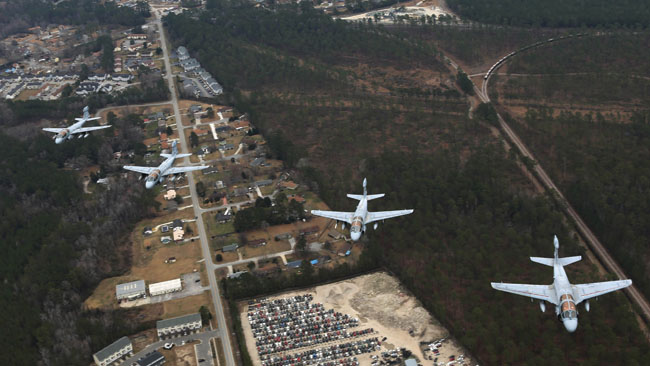
3 Jan 2016 and the last time Prowlers from all four Marine VMAQ squadrons flew together as the first unit, VMAQT-1, would be deactivated the following April. They’re shown here flying near their home of Havelock, North Carolina. – US Marine photo, CPL N.H. Quinone
The Marines, which did not procure the Super Hornet, chose instead to continue flying the EA-6B for several more years. In order to insure a constant stream of trained aviators and maintainers, VMAQ-1 took over the replacement training (“RAG”) function in 2013, being re-designated VMAQT-1. But even the Marines had to retire the Prowler at some point. The decision was finally made to start deactivating squadrons, one per year, from 2015, starting with VMAQT-1 in April 2016. The remaining three units continued deploying, now providing critical EW support for counter-ISIS operations in Iraq and, soon, in Syria. The Seahawks of VMAQ-4 were the second to go, deactivating in June 2017. Then it was the fabled Moon Dogs, who were put-down in May 2018.
This left the “Death Jesters,” who made one more long deployment to Al Udeid, Qatar. It was a combat deployment, of course, and it included operations throughout the Central Command AOR. They came home to North Carolina in October 2018 and started the path toward deactivation.
It truly marked the end of an era; both for the Marines and their long, distinguished history as leaders in the EW business, but also for the Grumman EA-6B Prowler, which had become, arguably, the most significant EW aircraft in history over its many years of service.
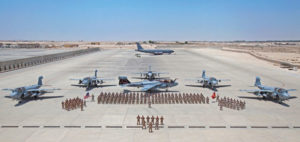
The men and women of VMAQ-2 stand before the squadron’s six EA-6B Prowlers at Al Udied, Qatar during the unit’s final deployment, on 16 August 2018. They would be replaced by Navy squadron VAQ-135, flying EA-18Gs. – US Army photo, SPC Jorge Diaz
The decision to retire the EA-6B without direct replacement was not without some controversy within the Corps. While the Navy was “all in” for the Boeing EA-18G Growler as an EA-6B follow-on, the Marines have pursued a different path. There remain more than a few voices that would tell you that the loss of the VMAQ community will leave a capability hole that cannot be easily filled. In particular, the talents and knowledge resident in the Electronic Countermeasure Officer (ECMO) specialty will be sorely missed both in the field, as well as on staffs and in schools.
Now dedicated manned EW support aircraft (like the Prowler) will be replaced by a rapidly evolving concept called Marine Air-Ground Task Force Electronic Warfare (MAGTF EW), which will combine specialized packages on a range of aircraft and drones that will be linked to a Radio Battalion on the ground to provide sensing and EW fires to support the Marine Rifleman.
The Marine Prowler legacy is a great one and will be a hard act to follow by whatever system, or systems, eventually arrive to replace it. More than the airframe, however, it was also the men and women who flew and fixed the aircraft that were truly, “In the Best Tradition of the Corps.”
About the Author: Rick Morgan, LCDR USN (Ret) is the historian for the Prowler Association with over 2000 hours in the EA-6B over 12 years of flying the aircraft. He currently lives outside St Louis, MO with his wife Julie and two cats. While not a Marine, he helped train a lot of young Marine ECMOs at VAQ-129, and his son Scott served five years in the Corps with two tours in Iraq. He served on the AOC National Board of Directors 2008 to 2010.
For more information on Marine AEA history, the author highly recommends “Silent Heroes” by H. Wayne Whitten, COL USMC (Ret).
Prowler Association:
www.ea6bprowler.org
If you enjoyed this article, please share. If you would like to read more articles like this one, we encourage you to join the AOC to receive a copy of JED every month.